3 Beginner Poses for Stand-Up Paddleboard Yoga
“Yoga is my favorite way to pretend like I’m working out”
Over the Fourth of July, I decided to take my love of stand-up paddleboarding and yoga, and give SUP yoga a try. I mean, I’m great at paddleboarding, I’m good at yoga, how hard could combining the two be?

One of my finer SUP yoga moments.
Turns out, very hard. I was not good. However, I did enjoy giving it a try.
In between failed attempts and splashdowns in the lake, I did find a couple poses I could do moderately well. Kind of makes we want to keep trying.
If you’re interested in giving SUP yoga a try, you should. Rather than try for a headstand, tree pose, or something equally advanced right out of the gate, allow me to recommend three poses that are moderately easy on the paddleboard. A great way to get your feet wet, without actually getting wet, if you catch my drift.
Below are three good SUP yoga poses for beginners. I also chose these three because they’re pretty common so most who practice yoga, even beginners, are familiar with them.
1. Cobra
After you’ve paddled out to your destination, why not stay on your belly and enjoy the feeling of a good Cobra pose?

Not the finest but a good addition to the sesh.
2. Downward Dog
Another favorite of many who practice yoga, downward dog offers a ton of benefits. It’s also a nice transition from the stability of a belly-down position on your paddleboard.
3. Warrior
I’ll warn you – this one’s not nearly as easy as the other two. Getting your feet properly positioned takes a lot of balance. As you can see from my photo, I didn’t exactly master this one on my first try. But it’s worth trying. It’s one of those poses that makes you feel so strong and powerful. I supposed that’s why it’s called Warrior.
Have you tried stand-up paddleboard yoga? Was it a success or more of a disaster? Comment or tweet me, @LindsayIRL. Share your pics on Twitter and Instagram too, and be sure to use hashtag #wellirl.
Why We Run
“Baby we were born to run”
Nearly two years ago, I ran my first race as an Ainsley’s Angels runner. If you’re not familiar with Ainsley’s Angels, it’s a great group that pairs up special needs kids with runners to push them in races.
We have a race coming up, the first one we’re hosting since our chapter was established. Last week, I got together with my teammates, Trav and Riley, to do a little stroller-running practice.
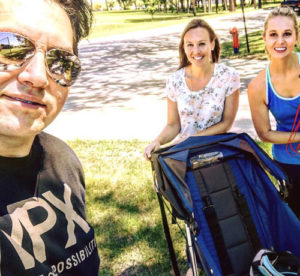
Team Shamus for the Sunrise 5k
You may remember Trav from his interview I shared on the blog a year ago. If you live in the Fargo-Moorhead area, you might recognize Riley as the morning anchor on our local ABC affiliate.
As we were wrapping up, we started talking about running – how much we all love it and the reasons we do it. And wouldn’t you know, not a single one of those was weight loss. Not a single.damn.one.
In all reality, of course weight management is an awesome benefit of running. Between the calorie burn and muscle strengthening, I’d be lying if I said I didn’t appreciate the positive way it affects my body. But there are plenty of forms of cardio that achieve those results – cycling, swimming, even an elliptical machine.
As I’ve continued to run throughout the years and talk to others who also run as a religion, I’ve found that rarely is weight loss a reason that anyone loves to run and continues to do it.
Between Trav, Riley, and me, here are the reasons we love running. If you ever need something to give you a good kick in the butt (and don’t we all some days?), feel free to draw on these for inspiration.
1. It Makes Us Feel Great
This one is so hard to argue. While we agree that sometimes, it can be hard to get up and go for a run, it feels so good after, both mentally and physically. And then there’s the racing side of it.
I remember finishing my first 20-mile training run for my first marathon. I felt like such a badass. I recall talking with Trav and the pride he felt crossing the finish line of his first half marathon. There’s no better feeling. Running lets us capture those moments every time we choose to lace up and hit the pavement.
2. It’s Stress Relief
We all have stress in our lives. For Trav, he’s working all the time, and has his hands in tons of different projects. For Riley, I mean, the girl is on live TV every day. ‘Nuff said. For me, I balance writing for editors to meet tight deadlines, pulling together reports for our C-Suite, and fielding other requests that come my way as my company’s sole PR Specialist. And those are just our work lives.
Running is powerful stress relief. There’s just something about it that helps us unwind and deal with things that consume our day-to-day lives.
3. It Does Good
Ainsley’s Angels is a perfect example of how running benefits others.
And you don’t have to volunteer with a group like we do; there are plenty of races that allow you to fundraise for great causes. In other races, just by running and paying the race fee, you’re supporting a charitable organization.
4. It’s Fun
Oh, this one. Whenever I tell people, non-runners, that I love to run because it’s fun, I’m greeted with horrible blank stares.
With runners though, they totally get it. Especially in a team setting with a fun race like Trav, Riley, and I are going to run, it really is so much fun.
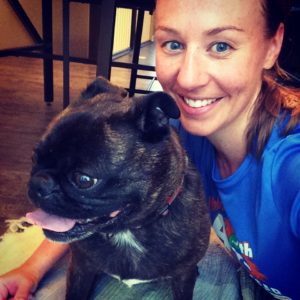
My favorite four-legged running partner
5. It’s For Everyone
I enjoy long distances and 8-minute miles with the company of my dog. Trav digs the half marathon, has been gradually increasing speed, and enjoys group runs. Riley has done a 10k and handfuls of 5ks, and is shooting for 10-minute miles in our next race.
Difference distances, varying pace-per-miles. And guess what – we’re all runners. At the end of the day, it doesn’t matter how far, how fast, or how often you run. If you run, you’re a runner.
Speaking of that, join us for the Sunrise 5k on July 1. Walk, jog, run, whatever’s your pleasure. If you don’t live in the Fargo-Moorhead area, no worries, there’s a virtual option. Sign up here.
Do you run for reasons other than weight loss? What is your number one reason you run? Comment or tweet me, @LindsayIRL. Share your reasons to run on Twitter and Instagram too, and be sure to use hashtag #wellirl.
Respect for the Shirtless Runners
“Hot child in the city, running wild and looking pretty”
Summer is here. Well, not officially, at least according to the calendar. But in terms of weather, particularly, running weather, it’s hot, hot, HOT. With that, last week began the time of year in which I never used to take part. Yes, I think we can safely say it’s time to ditch the tops and run sans shirt.

It took me 10 years but I can finally head out for a run like this.
For those who don’t know me well, this has been a step for me. Prior to last summer, running shirtless was something, in my decade of the sport, I had never done. It’s not that I’m ashamed or embarrassed by my belly; it’s a product of my genetics and, mostly, my love of food. I even wear a bikini at the lake.
That’s the difference though: Spending the day shirtless at the lake? Acceptable, even expected. Out for a run, shirtless, through the southern neighborhoods of my city? Unnecessary, even attention-seeking.
But as someone who’s Function over Form (both in personal and professional life), I started thinking about the simple functionality of running shirtless on very, very hot days.
It was a few months after my first shirtless running experiment I learned I wasn’t alone. You may have heard of @KellyKKRoberts, a runner who has been proudly running in her sports bra for quite some time. Similar to me, she was self-conscious to run shirtless. And similar to me, she decided it was just to effing hot and running in just a sports bra was so much more comfortable. In fact, her brave movement inspired a following knowing as the #SportsBraSquad. Basically, a group for anyone who enjoys the comfort of running shirtless and doesn’t care what anyone thinks of it. And for all you guys out there, @BareThomas10, also known as Running Shirtless, spreads the message of running shirtless.
Not saying I’m a full-on member of the #SportsBraSquad or Running Shirtless crew. I do it only when absolutely necessary. I do it only when I decide shedding the shirt is worth it to gain a degree or more of coolness on my body. In summary, I do it only when it’s hot AF. But I’ve come a long way and thank goodness – this summer is already off to a hellishly hot start.
My respect to you, Kelly and Bare Thomas. Thanks for reminding us all we’re strong and awesome and totally justified to ditch our shirts!
When it’s hot outside, do you run, bike, walk – whatever it is you do – shirtless? Or do you prefer to keep it all under wraps, regardless of the heat? Comment or tweet me, @LindsayIRL. And because shirtless is as real as it gets, don’t forget to use the hasthtag #wellirl.
Wellness In Real Life
“Keepin it real”
If you follow me on social media, you may have noticed my handles have changed. Depending on how familiar you are with my blogging or you found this blog entry, you may also notice you’re reading it on a new site. I didn’t get hacked, both are intentional! I’ve changed the name of my blog and moved to a new site – welcome to Wellness In Real Life.

Still a running girl – with her dog
When I first began blogging a few years ago, I was mostly focused on running – who am I kidding, I still am. But as I continued to write, I realized my life was less about just running and more about striving for wellness. Running just happens to be a major player in my quest for wellness, physical and mental. And that’s not changing any time soon, unless my body just up and falls apart…
So why the name change? I mean, really, “What’s in a name?” Thanks to the Always ‘Like A Girl’ campaign that launched a couple years back, girls’ running groups, and the recent rise of new-age, social media feminism (none of which I’m associated with), my original name, ‘Run Like A Girl’ has taken on a life of its own. It has become almost gimmicky and doesn’t really jive with the reason I originally chose the name – which was, simply, because I’m a girl. So I run like one.
Another common theme in my writing is honesty – no matter how unpleasant, feisty, or, sometimes, gross it may be. Working out, eating right, controlling stress, everything that goes into wellness, it’s not always pretty. Working out takes, well, WORK. Being hungry sucks. Some days, cardio is the worst. And I can’t even imagine the tough days for all you parents out there. All in all, there are times it all just sucks. Bad.

I really, really like food
I’ve never been one to sugarcoat. Pretending I don’t enjoy chocolate and waffles and Cheez-Its? That’s not real. Saying I pop out of bed and go running at 5 a.m. with ease? That’s not real. Taking 100 gym selfies to get one that hits the perfect balance of looking like I’m working out, yet maintaining a perfect ponytail, and flexed butt and biceps? That’s not real.
In short, there’s a lot of fake stuff, bullshit advice, and things that just aren’t realistic in our real lives. Wellness is choices, it’s work, and it’s an ongoing effort.
Yes, I’m all about keepin it real. And I felt a new name would better represent me – what I’m, my writing, and my mission is all about.
So once again, welcome to Wellness In Real Life. I’m still working on the site and fully transitioning, so there are still some hints of ‘Run Like A Girl’ here too – I don’t want to totally confuse everyone who visits just yet. Above all else, it’s still me so I hope you’ll stick around and keep reading.
As always, if you have comments, please leave them below. For questions or other things to say, tweet me, @LindsayIRL. And use the hasthtag #wellirl to share your real-life wellness moments – the grosser, funnier, and real-er, the better.
The Hardest Part of Marathon Training Comes After 26.2
“You can’t start the next chapter if you keep re-reading the last one”

Two members of my pace crew – started together, finished together.
Another Fargo Marathon in the books. This year’s race was one of the most fun for me, as I had the privilege of leading one of the pace groups. While I was nervous for my first assignment as a full marathon pacer, those nerves quickly went away, as I laughed, encouraged, and bonded with some great people throughout the streets, bike paths, and college campuses of Fargo and Moorhead.
Like other marathon runners, the hardest part of marathon training is here – what to do next. There are several reasons post-marathon time is tough but unlike other marathon runners, I don’t have the “whats” part of it to deal with. You know the “whats”:
“What could I have done differently?”
“What if I had run the first few miles a little faster?”
“What should I have changed with my training to do better?”
Runners are notoriously hard on themselves, often dissecting and analyzing every part of the race, every step in the training process, all to know what they could have done better.
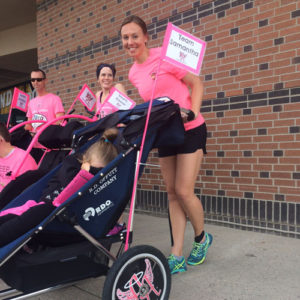
What’s next for me? More fun runs with Ainsley’s Angels
As a pacer, I had a different approach than most runners hoping for a personal goal; I simply had a job to do and, I’m happy to say, I believe I did it well. So I get to look back on this year’s event and training with no regrets, no “whats,” but I sympathize with runners right now who are dealing with, both the scrutinizing “whats” and the big question: “What do I do now?” That’s why I offer up a throwback blog, how to beat those after-marathon-blues.
Those of you who recently ran a marathon, whether Fargo or other, I invite you to read as well. Remember to celebrate your accomplishment. No matter how race day turned out, you worked hard for months and that alone is worth recognizing. Most importantly, it will help you move on to a better “whats” – what’s next!
If you like this post and think other runners would too, please share it on Facebook or Twitter. As always, if you have questions or something to say, please leave a comment or tweet me, @runlikeagirl311.
Why You Should Run With a Pacer – And Why You Shouldn’t
“Follow the leader”
Iiiitttt’ssss Marathon Week! After a long winter of training, it’s hard to believe the big day is almost here. On Saturday, along with thousands of runners, I’ll step up to the start line at the Fargo Marathon, my eleventh consecutive year running my beloved hometown race.
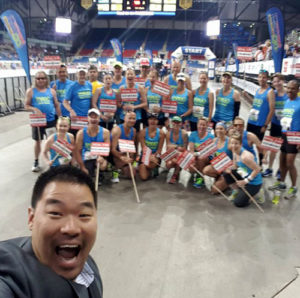
I’m THIS EXCITED for marathon Saturday
What’s different about other years I’ve run the full marathon is this year I’m doing it as a pacer – my first time pacing a full 26.2 endeavor. I’m leading the 4:20 finish group so hoping I have a couple first-timers run, at least part of their journey, alongside me.
As a pacer, I’d love to tell you all the reasons why running with us is a great idea. And, as a runner who never ran in a pace group myself, I feel I should give you the other side of the story, too. So here they are, the reasons why running with a pacer is a great idea – and, why it may not be for you.
To help illustrate, I’ve identified five types of runners; hopefully you can see some of yourself in one – or all – of these.
1. If You’re a First-Timer
I identify the First-Timer as, maybe not a rookie racer, but a first-timer in his or her respective race, whether a full or half marathon, a 10-miler or 10k.
Why You Want to Run With a Pacer
The most obvious of all, it’s your first race! A pacer will help calm your nerves, keep your adrenaline in check, remind you to take fluids or gel, and, most importantly, keep you positive. Not only that, you’ll get the camaraderie of the full pace group – you’re all in it together.
Why You Don’t Want to Run With a Pacer
Especially for your first race, it’s easy to get caught up in the excitement and push too fast to keep up with a group. Conversely, you may end up underestimating yourself and be held back by the group you thought would be the right pace for you. Remember, a pacer knows how to run the race really well. But you know YOU really well.
2. If You’re a Type A Runner
I identify the Type A runner as the runner who has a plan on race day. Not only do these runners have have a goal finish time, they likely have a target pace per-every-mile. They’ve looked ahead at the course and have strategy for navigating turns and hills. They even a plan when they’ll take their gels and water stops. Full disclosure, I am the Type A Runner.
Why You Want to Run With a Pacer
The only scenario you’re likely to even consider running with a pacer is if you aren’t totally confident in the ability to pace to your goal. While it’s hard for the control freak to put their trust in someone else, the Type A Runner may see the pacer as a way to maintain the target and, ultimately, achieve their goal.
Why You Don’t Want to Run With a Pacer
The Type A Runner needs to be in full control of every aspect of the race possible. That’s pretty much the end of this story.
3. If You’re a Lazy Runner
No, not an oxymoron, there is a type of runner who I’d identify as “lazy” on race day. They’re the ones who put in the training but, when race day comes, they back off and don’t push it. Don’t get me wrong, there’s nothing wrong with this. I myself have taken a day or two off from being a Type A Runner to enjoy the spoils of a lazy marathon.
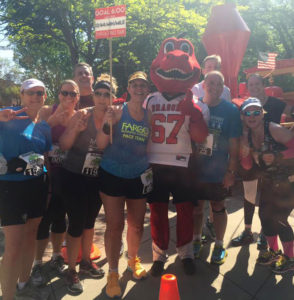
Pacers make it fun – mascot selfies and all
Why You Want to Run With a Pacer
Another pretty obvious one – if, deep down, you want to achieve a PR or other time goal, running with a pacer will give you the push you may not otherwise do on your own. Also, you’ll likely enjoy the fun of running in a group.
Why You Don’t Want to Run With a Pacer
Often, the Lazy Runner is lazy because that’s how they enjoy running. Taking in the sights and sounds of the race, getting lost in the moment, not worrying about their watch. If this is how you enjoy running, make no apologies, and just enjoy it.
4. If You’re An Energy Feeder
Kind of the opposite of the Lazy Runner, I define the Energy Runner as one less disciplined during training but then feeds off all the energy and excitement on race day. They’re energetic early on, but may start to fade before they see a mile marker with a number in the 20s.
Why You Want to Run With a Pacer
All that energy in one bunch? A leader keeping the group motivated? Extra cheers from the crowd directed towards the entire group? You’ll love all the added motivation and camaraderie built-in throughout the course. And if you choose to line up with a group that’s running a pace realistic to what you can maintain, it might help from going out too fast, too early, and conserve your energy.
Why You Don’t Want to Run With a Pacer
The extra excitement and early energy bursts might cause the Feeder to experience an earlier-than-usual bonk. If you’re prone to this, it might be best to stay focused on you vs. others – notice your breath, how you’re feeling, your stride, and do what feels right.
5. If You’re A Repeat Offender
Repeat Offenders – many of us fall into this category, even if we’ve already identified a fit in one of the four above. I identify the Repeat Offenders as the ones who have run their particular race, from 5k to marathon, numerous times. They know how their body and mind react through the miles, and probably have a good idea of how to pace themselves on their own.

Repeat half marathon offenders – my pal, Dakota and me
Why You Want to Run With a Pacer
If you haven’t yet hit that PR or time goal you’ve been wanting, this is a great chance to do so. Because you know these miles really well, you’re likely to choose a realistic pace group and use that to hit a goal.
Why You Don’t Want to Run With a Pacer
It has been said before and will be said again – the pacer knows the course and mile splits, but no one knows you better than you. If you’re seeking a new PR, running on your own is a great opportunity to teach yourself the art of pacing and make you a stronger runner. And, as an experienced runner and one who keeps coming back for more, you certainly don’t need the energy and extra push that a pacer provides.
Just as every runner is different, every runner on race day is different. Between the weather, nerves, sleep, and about a million other variables, you never know how race day is going to shake out. Always do what feels right for you.
If you’re considering running with a pacer, the best advice I can give is to start in the group, then either get ahead or drop back depending on the feels.
Have you ever run a race with a pacer? Why or why not? If you did, was it a good experience? Comment below or tweet me @runlikeagirl311 on Twitter.
As always, if you liked this post, please share it on Facebook or Twitter, along with any upcoming races you’re training for.
Why You Should Run the 0.1 or 0.2
“You don’t have to go the extra mile, only part of it.”
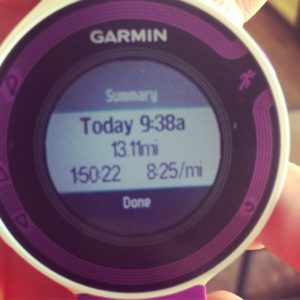
Respect it, train for it
I’m fresh off pacing my very first 10k event, part of the annual Minneapolis Get in Gear race series. It was a great time, filled with several of my usual pace experiences – running with awesome people, getting hugs, at least one person asking about my pacer sign, and even a post-race photo request with a proud finisher.
What was interesting, though, was a question I got about a mile into the race; one I had never been asked before but is part of my strategy every race. A fellow runner asked how I factor the 0.2 into my overall pace to hit the goal finish.
Let me tell you, I respect that 0.2, both in a 10k and a marathon. Same with the 0.1 in a 5k and half marathon. Whether I’m training, racing, or pacing, I’m very conscious of races that don’t end on an even mileage number, which is most of them, and I factor that mileage number into my overall time and pace strategy.
In a nutshell, I always – repeat ALWAYS – train for the 0.1 or 0.2 by adding that little extra mileage onto my long runs, and some of my shorter ones, too.
This isn’t just me, I do it when I create running plans for others. I recently created a half marathon training plan for my friend, Jess, and you can bet her long run goals ended with a 0.1.
Why do I feel so strongly about the 0.1 and 0.2? Why do I always train for it and suggest you do too? Here’s why.
Train for Distance
A 5k is 3.1 miles, not 3. A marathon is 26.2 miles, not 26. So, I see this question as, not, “why do I train for the extra distance,” but “why would you NOT train for the extra distance?” And, p.s., it’s technically not ‘extra’ distance, it’s simply the total distance. It’s going to show up on race day so it needs to show up on your training days.
Train for Mental
You know the joke, “A person who says a minute goes by fast has never been on a treadmill.” If your mind has you banking on ending your run as soon as the watch chimes on the even mile, those last few paces are going to feel incredibly long and painful.
Train for Extra-Long

Enjoy that last 0.2 and the stretch to the finish line
All watches don’t track distance the same and rarely does a race end on the exact distance it’s advertised. More often than not, races go long. My 10k I just paced, for example, ended as 6.3 miles, while a full marathon I ran a couple years back was closer to 26.4 (according to my watch). In these cases, the total distance was closer to a half mile more than the even mileage number – pretty significant. All the more reason to get yourself prepared to push a little further with every long run.
Train for a PR
Remember how I talked about the mental aspect of having to keep running those last fractions of a mile when your brain thinks it should already be done? If you’re going for a specific time goal and you don’t factor in that extra distance, it can be the difference between a solid PR or blowing up your time. If you train for the added distance, you’ll already be used to accommodating it and the extra time it adds to every run.
How many of you already train for the 0.1 or 0.2? Just me? Comment or tweet me, @runlikeagirl311.
As always, if you liked this post, please share it on Facebook or Twitter. If you want to go ahead and include a photo of your watch, showing the miles you ran – with the 0.1 or 0.2, of course – that would be supercool!
The Value, Power, and Importance of Failure
“In order to grow, first we must fail”
It’s here – the week of the 121st Boston Marathon! I’m so excited for, and very jealous of, all the wicked fast runnahs who get to go to the expo and pick up their bib, take in all the energy and sights of the city, and make the trek from Hopkinton down Boylston Street. And, of course, enjoy the victory and a special 26.2 brew.
For many, the Boston Marathon represents years of hard work; for others, it represents the ultimate goal; for an entire city, this week brings painful memories yet is an example of people coming together and coming out strong – one might say, #BostonStrong.
The Boston Marathon means something a little different to everyone, from major significance to nothing at all. For me, it has changed throughout the years, starting as a measure of prestige, evolving into a dream, becoming a reality, and now being a special memory.

Cheers to taking risks & being okay to fail
But more than that, for me the Boston Marathon is an example of the value of failure.
Failure? Isn’t a marathon, especially this one, an example of success?
I’ve shared my journey to the Boston Marathon, my quest to run a marathon in a qualifying time to earn my spot. How hard it was to miss the qualifying mark, not one, but two times, before achieving the goal. How I was able to learn from each failure and apply it to my next training season and race. How my fear of failing nearly got in the way of success.
I think that’s the part of my story that’s most important. We’re taught from a young age that failure is a bad thing. It starts with the shame of bringing home a failing grade on the report card. It follows us to adulthood where the word itself takes on a new, more intense meaning, the conversation going from, “I’m scared to fail,” to, “I’m scared of being a failure.”
Yikes. The problem with this is that failure can be a really good thing. It can mean you’re trying something. It can mean you’re going out on a limb. It can mean you’re taking a big risk. And what’s the payoff to a big risk? A big reward. If you never try anything big, you’ll never achieve anything big.
From muscle failure in the gym to personal failures in everyday life, we grow so much more when we fail first.
What have you achieved in life that you can attribute to failure? Comment or find me on Instagram or Twitter.
Behind the Scenes Running 26.2 – Part 3: How to Run the Marathon
“No one fucks with someone who runs 26.2 miles for fun”
We’re closing in on spring marathon season. Whether Boston this month or a local race next, you’re all in at this point. You’re tough and you’re tired. Your metabolism is high and you’re hungry all the time. You’re so excited and so exhausted. All in all, you’re a badass.
Hopefully your training has gone well. But all that time you’ve been putting in to weekly mileage goals, calculating long run splits, counting carbs and protein – have you stopped to think about executing on race day?
Marathon training is so consuming, many of us lose sight as to why we’re actually doing it. Now, it’s time to focus on what to do when you step up to the start line on race day.
Closing out this marathon-focused, three-part mini series on the blog: How to navigate, enjoy, or just get through those 26.2 miles of a marathon (with Parts 1 and 2 included).
The Start Line
What to expect
People. Everywhere. From fellow athletes and pace leaders to race officials and spectators, the area will be full of people.
How to train for it
On days that are tough, visualize this moment. Remind yourself of the pride and excitement you’ll feel stepping up to the start line with your fellow athletes.
What to do on race day

Find us. We’ve got your back.
Find your correct spot. Unless your name is Meb, Shalane, or something equally elite, don’t line up at the front of the pack. You’re going to piss off those racing for a win or top finish, and throw off your entire pace within the first mile. Instead, locate the pace leader that’s nearest your goal finish time or the one that matches your pace. You don’t have to line up with them but at least use it as a guide to know where you should be.
Mile Markers 1-4
What to expect
The crowd will be thick and adrenaline high. You’ll be excited and may feel tempted to push your pace to get around people or, simply because you feel great.
How to train for it
Do plenty of easy practice runs to hone in on your comfort pace. This pace will be what you strive to stick to throughout the miles – not so easy that it throws off your stride, yet not too fast you risk emptying your tank too early.

Up early, out in the cold just for you – volunteers are the best.
What to do on race day
Thank the volunteers and spectators whenever you get the chance. As the miles go by and you get fatigued or in a zone, you may become numb to the outside world so take the time to show your gratitude now. These people deserve it.
And that temptation to push your pace and race, obstacle course-style, around other runners? Resist. Run at the pace you’ve trained to run at or maybe just a little bit faster.
Mile Markers 5-8
What to expect
You should feel good and strong, likely having settled into a comfort pace. The crowd, while thinner now, will still be fairly close together.
And if you’re running a race that has a four-person relay, you’ll hit the first relay exchange point in this mileage block. Expect a ton of spectators (feed off their energy), possibly some minor congestion (runners will be switching in and out), and a sudden burst of faster runners around you (the newbs that just hit the course).
How to train for it
Practice your early hydration strategy during long runs. These miles are when you’re going to need your first pit stop or two for water or sports drink. Get used to, both the concept of running slowly while drinking (expect spills and liquid up your nose) and the feeling of having a little liquid in your belly while running.
What to do on race day
Because the pack will still be close and you’ll encounter a relay checkpoint, remain aware of your surroundings and keep in tune with your pace so you stay on track. If you haven’t yet stopped at an aid station, it’s a good idea to down a couple sips of water or sports drink in this mileage block.
Mile Markers 9-13
What to expect
It’s unlikely fatigue will have set in yet. Those of you who have run a half marathon will likely notice how much better you feel now, compared to how you feel at this point in a half marathon. You should feel mentally good that you trained hard and are poised to hit the second half of your race, and physically up to the task.
How to train for it
Try to incorporate a few 9, 10, and 11-mile runs into your training plan, outside of your long runs. I can’t tell you how big a confidence booster it is when you can hammer out 10 miles on a Monday night – especially considering that was a “long” run for you only a few weeks ago.

Love your muscles, grow your muscles.
Another thing you should incorporate into your training is weight lifting. Specifically, upper-body focused lifting. Think about your body when you run. Shoulders back and strong, core tight, arms pumping – your upper body plays a big role in sustaining long distances. Conversely, a weak upper body might be shoulders hunched, core not engaged, and arms simply stabilized – not ideal for continuing another 13 miles.
Those of you shaking your heads and saying, “I don’t have time or energy for that, I’m training for a marathon!” believe me, I feel you. The more you run, the harder and more frustrating lifting can be. But I’m only talking 20-30 minutes one or two times a week. That’s enough to give you the benefits and doable to incorporate into your busy schedule.
What to do on race day
While most runners won’t feel fatigued yet, if you do, consider taking an energy gel pit stop. Keep it quick though, you don’t want to fall out of your rhythm too much this early on. Also, resist the urge to stop and stretch this early, as it could actually cause your muscles to feel sore or stiffen up too soon.
Mile Markers 14-16
What to expect
Mentally, this is a good place as you’ll know you’re more than halfway there. That said, slight fatigue may start to set in your legs, glutes, even upper body, especially if the weather is significantly different than what you’ve trained in. Upside, you’ve likely seen some really great running signs by this point – and there are more to come!
How to train for it
Practice eating an energy gel, blocks, or something of that nature on your long runs as this will likely be the point you’ll want your first boost. Be sure you have water along, as all energy products go down and sit in your stomach much better with water. Plus, it’s just a good reason to make sure you’re replenishing fluid and staying hydrated.
What to do on race day
If you haven’t yet, take that energy gel pit stop. Again, keep it quick so you don’t lose your rhythm or give your muscles a chance to stiffen up. Then get back out there. You should feel good and a boost of energy post-gel!
Mile Markers 17-19
What to expect
I’m gonna give you the bad news first – these three miles are often the most mentally-tough ones of the race. You’re far enough in now that you’ll be feeling some fatigue, yet you feel so far from the finish line.
The good news, though, is if you haven’t yet had any issues with stomach trouble, you’re likely not going to as long as you stay properly hydrated. High-fives for successfully avoiding the port-a-potties!
How to train for it
Schedule at least one long run that exceeds 19 miles. If you’re run a marathon or two, you may even consider two that hit the 20-mile mark.

Those big legs & butt will be your BFF on hills & in the late miles.
And, I’m going to hit you with one more lifting task – this time, for your legs. Olympic hockey coach Herb Brooks famously said, “The legs feed the wolf,” referring to the intense conditioning he imposed on his players (I’m not sure of the factual nature of these words; this may have been a quote written into the movie for entertainment value but I still love it). Basically, stronger legs are going to be your friend as you head into your final miles, and running alone won’t get your legs to their full potential.
Be the best conditioned you can be by incorporating one dedicated leg workout into your week – again, I’m talking just 20-30 minutes, focused on quality moves like squats, single-leg deadlifts, and glute work.
What to do on race day
At this point, your mental game needs to get strong. Remind yourself the miles you have left is a single-digit number. Hooray! Remember how quickly mile-marker 9 came today? That’s the most you have left to go. You’ve trained for this distance, you can go further.
Mile Markers 20-26
What to expect
You’ll feel tired. You may find yourself wondering why you signed up to do this. You may be tempted to walk or stop altogether.
How to train for it
Towards the end of training and during your biggest long runs, start pushing your pace in the final four miles. Practicing a strategy of digging deep and pushing those last miles vs. slogging through and mentally cursing them will pay off.
What to do on race day
Remember when I told you your mental game needs to get strong in miles 17-19? It’s going to get you through these miles even more so than your legs. Yes, the mental game is THAT important in finishing a marathon.
Because these miles can be so daunting, mentally and physically, there’s a strategy that many people (including yours truly) have used on race day. Assign something to every mile. Something you’re running for; something that can keep you going. I’ll share my examples to show you what I mean.
I’ve dedicated mile 21 to my friends Megan and Sue’s mothers who passed away from cancer. Thinking of them and all the other people trying to beat the disease made me feel strong and like I could do it.
I’ve dedicated miles 22 and 23 to people who wish they could run but can’t. Either they’re too afraid to try, or they’re injured and wish they could be running. Thinking of them has made me feel grateful that I get to run marathons.
I’ve dedicated miles 24 and 25 to my biggest supporters. My parents, family, and friends who have encouraged me and who I know are mentally cheering me to the finish line in that moment. And, obviously, the most important person and one who has sacrificed the most for me to be there, Chris. Thinking of them always makes me feel determined and like I can’t let them down.
And I always dedicate mile 26 – and the 0.2 – to myself. Because, ultimately, I run for me.
The Finish Line
What to expect
Emotions and extremes. You may cry, you may laugh; you may feel a burst of energy or like you’re going to pass out. Either way, you can’t help but feel pride. I don’t care if it’s your first marathon or tenth. It’s an incredible accomplishment that comes with an incredible feeling.
How to train for it
Likewise with the start line, on days that are tough, visualize this moment. After long runs, practice your immediate recovery strategy so you can implement it on race day. Whether it’s a pared-down version of stretches, putting your legs up against a wall, eating – it will all help you navigate the post-race area and ensure your recovery gets off to a good start. Also, always go for a short walk a couple hours after a long run; it will help your legs recover.

Meet up with friends & take obligatory post-race pics.
What to do on race day
Enjoy your victory! Happily accept your medal, walk the route that takes you through photos, water, snacks, and the meeting area. Be sure to take water. Enjoy a snack right away, if your stomach is up for it – if not, at least take something to-go. Do a quick stretch and keep moving so your legs don’t cramp and stiffen too badly.
Throughout the afternoon and evening, force yourself to get up and go for quick walks. It may seem like resting all day after a marathon is the best strategy but it’s the opposite. Keep moving! Also, if at all possible, avoid stairs. If you must, take no shame in using the handrail.
There you have it – what to expect from a marathon, how to train for a marathon, and how to run a marathon.
Good luck to all who have a spring marathon coming up! If you’re running Fargo Marathon next month, my lovely Twin Cities Pacers team will be out there with you; me, personally, leading the 4:20 finish pace group. Hope to see you out there.
Is there anything in this series I didn’t cover that you need to know? Leave a comment tweet me @runlikeagirl311 on Twitter.
Behind the Scenes Running 26.2 – Part 2: How to Train
“Tough runs don’t last but tough runners do”
It’s time for Part 2 in my mini-series designed for all you out there training for a marathon – especially your first marathon.

When you’ve trained hard for a marathon, it’s that much more enjoyable.
In this mini-series, I’m taking you through all 26.6 miles of a marathon – plus the before and after. Part 1 told you what to expect, now I’m going to offer tips on how to train for it, then finally, how to embrace, enjoy, or just get through it on race day.
Now, the second in the three-part series: How to train for running a marathon.
The Start Line
What to expect
People. Everywhere. From fellow athletes and pace leaders to race officials and spectators, the area will be full of people.
How to train for it
On days that are tough, visualize this moment. Remind yourself of the pride and excitement you’ll feel stepping up to the start line with your fellow athletes.
What to do on race day
Coming soon!
Mile Markers 1-4
What to expect
The crowd will be thick and adrenaline high. You’ll be excited and may feel tempted to push your pace to get around people or, simply because you feel great.
How to train for it
Do plenty of easy practice runs to hone in on your comfort pace. This pace is what you strive to stick to throughout the miles – not so easy that it throws off your stride, yet not too fast you risk emptying your tank too early.
What to do on race day
Coming soon!
Mile Markers 5-8
What to expect
You should feel good and strong, likely having settled into a comfort pace. The crowd, while thinner now, will still be fairly close together.
And if you’re running a race that has a four-person relay, you’ll hit the first relay exchange point in this mileage block. Expect a ton of spectators (feed off their energy), possibly some minor congestion (runners will be switching in and out), and a sudden burst of faster runners around you (the newbs that just hit the course).
How to train for it
Practice your early hydration strategy during long runs. These miles are when you’re going to need your first pit stop or two for water or sports drink. Get used to, both the concept of running slowly while drinking (expect spills and liquid up your nose) and the feeling of having a little liquid in your belly while running.
What to do on race day
Coming soon!
Mile Markers 9-13
What to expect
It’s unlikely fatigue will have set in yet. Those of you who have run a half marathon will likely notice how much better you feel now, compared to how you feel at this point in a half marathon. You should feel mentally good that you trained hard and are poised to hit the second half of your race, and physically up to the task.
How to train for it
Try to incorporate a few 9, 10, and 11-mile runs into your training plan, outside of your long runs. I can’t tell you how big a confidence booster it is when you can hammer out 10 miles on a Monday night – especially considering that was a “long” run for you only a few weeks ago.

My barbell earrings – because I really really like lifting.
Another thing you should incorporate into your training is weight lifting. Specifically, upper-body focused lifting. Think about your ideal form when you run. Shoulders back and strong, core tight, arms pumping – your upper body plays a big role in sustaining long distances. Conversely, a weak upper body might be shoulders hunched, core sagging, and arms loosely stabilized – not ideal for continuing another 13 miles.
Those of you shaking your heads and saying, “I don’t have time or energy for that, I’m training for a marathon!” believe me, I feel you. The more you run, the harder and more frustrating lifting can be. But I’m only talking 20-30 minutes one or two times a week. That’s enough to give you the benefits and doable to incorporate into your busy schedule.
What to do on race day
Coming soon!
Mile Markers 14-16
What to expect
Mentally, this is a good place as you’ll know you’re more than halfway there. That said, slight fatigue may start to set in your legs, glutes, even upper body, especially if the weather is significantly different than what you’ve trained in. Upside, you’ve likely seen some really great running signs by this point – and there are more to come!
How to train for it
Practice eating an energy gel, blocks, or something of that nature on your long runs as this will likely be the point you’ll want your first boost. Be sure you have water along, as all energy products go down and sit in your stomach much better with water. Plus, it’s just a good reason to make sure you’re replenishing fluid and staying hydrated.
What to do on race day
Coming soon!
Mile Markers 17-19
What to expect
I’m gonna give you the bad news first – these three miles are often the most mentally-tough ones of the race. You’re far enough in now that you’ll be feeling some fatigue, yet you feel so far from the finish line.
The good news, though, is if you haven’t yet had any issues with stomach trouble, you’re likely not going to as long as you stay properly hydrated. High-fives for successfully avoiding the port-a-potties!
How to train for it
Schedule at least one long run that exceeds 19 miles. If you’re run a marathon or two, you may even consider two that hit the 20-mile mark.

Strong legs means a smile on your face at the finish line.
And, I’m going to hit you with one more lifting task – this time, for your legs. Olympic hockey coach, Herb Brooks famously said, “The legs feed the wolf,” when imposing intense conditioning exercises on his players (I’m not sure of the factual nature of these words; the quote may have been written into the movie for entertainment value but I still love it). Basically, stronger legs are going to be your friend as you head into your final miles, and running alone won’t get your legs to their full potential.
Be the best-conditioned you can be by incorporating one dedicated leg workout into your week – again, I’m talking just 20-30 minutes, focused on quality moves like squats, single-leg deadlifts, and glute work.
What to do on race day
Coming soon!
Mile Markers 20-26
What to expect
You’ll feel tired. You may find yourself wondering why you signed up to do this. You may be tempted to walk or stop altogether.
How to train for it
Towards the end of training and during your biggest long runs, start pushing your pace in the final four miles. Practicing a strategy of digging deep and pushing those last miles vs. slogging through and mentally cursing them will pay off.
What to do on race day
Coming soon – this section will be big so get ready!
The Finish Line
What to expect
Emotions and extremes. You may cry, you may laugh; you may feel a burst of energy or like you’re going to pass out. Either way, you can’t help but feel pride. I don’t care if it’s your first marathon or tenth. It’s an incredible accomplishment that comes with an incredible feeling.
How to train for it
After long runs, practice your immediate recovery strategy so you can implement it on race day. Whether it’s a pared-down version of stretches, putting your legs up against a wall, eating – it will all help you navigate the post-race area and ensure your recovery gets off to a good start. Also, always go for a short walk a couple hours after a long run; it will help your legs recover.
What to do on race day
Coming soon!
Now you have an idea of what to expect throughout the 26.2 miles of a marathon and how to train for each moment. Are you still in? If so, comment below or tweet me with what race you’re training for and when it is.
Next month, watch for the final piece of this series, Part 3, that will provide advice for how execute your marathon from the start line, through the miles, and to the finish.
As always, if you have specific training questions, feel free to leave a comment or tweet me @runlikeagirl311 on Twitter with your questions or other comments.
